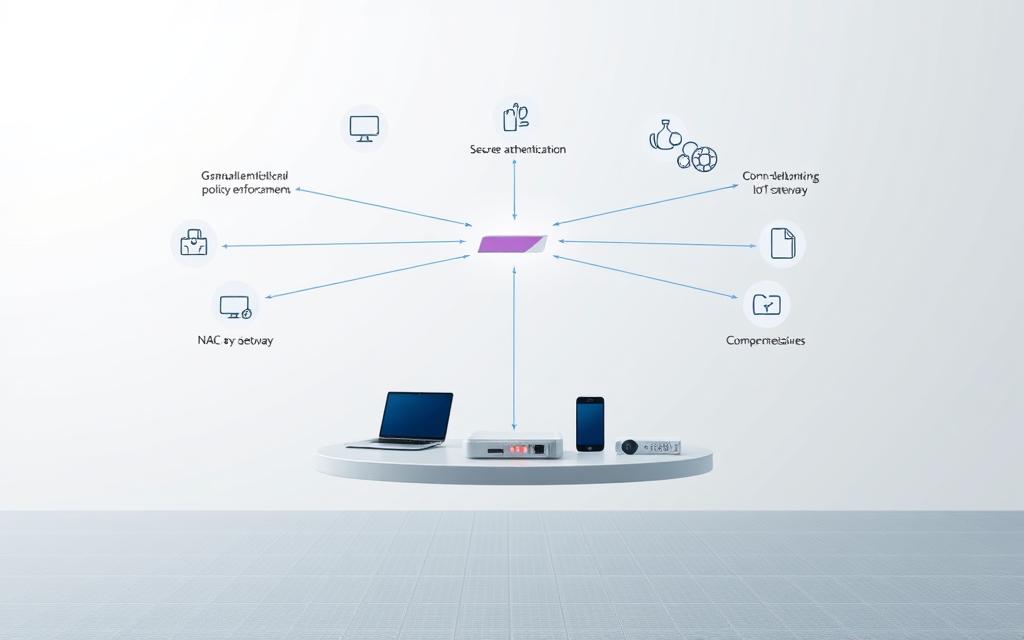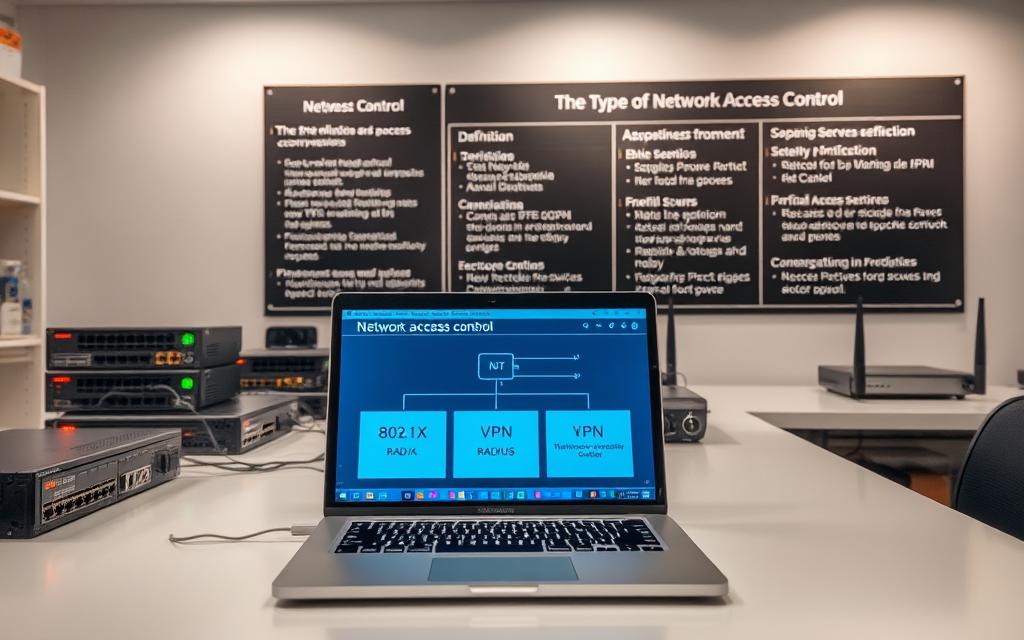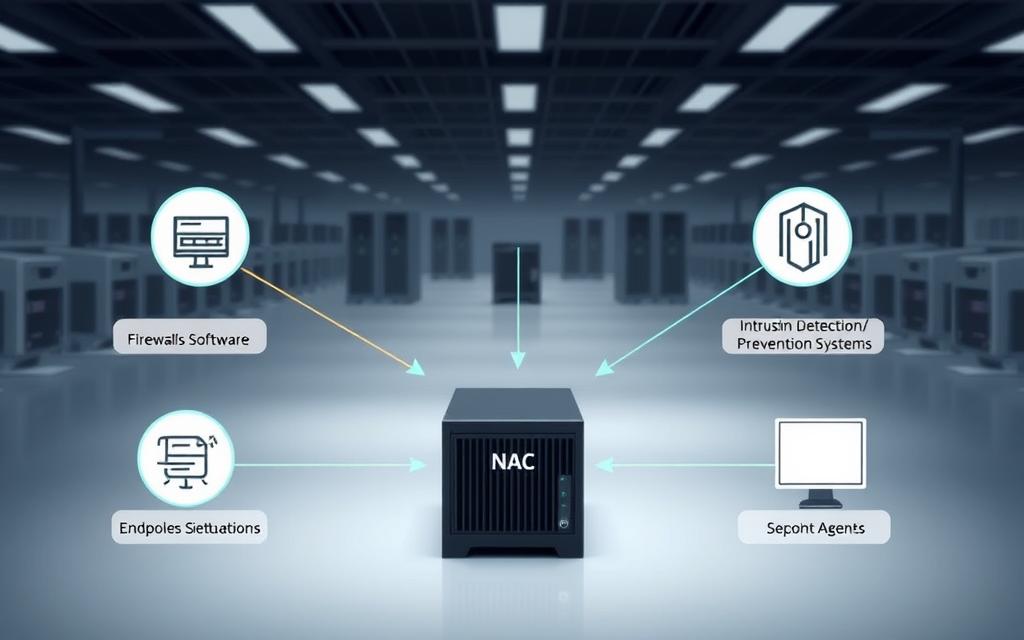Understanding Network Access Control (NAC) in Networking
Modern businesses face growing cybersecurity threats, making network access control essential. This security method ensures only authorized users and compliant devices connect to corporate systems. By enforcing strict policies, NAC minimizes risks from unauthorized access.
With the rise of BYOD and IoT, managing diverse endpoints becomes complex. Automated network security solutions like NAC streamline access while reducing IT workload. They scan devices, enforce compliance, and isolate threats before breaches occur.
Fortinet highlights NAC’s dual role: protecting resources while maintaining an inventory of connected assets. Suspicious activity triggers immediate responses, safeguarding entire infrastructures. This proactive approach is critical for enterprises prioritizing robust defenses.
What Is NAC in Computer Network?
Corporate networks demand advanced security measures to combat evolving threats. Unlike traditional firewalls, which rely on static rules, network access control adapts to real-time risks. It evaluates user credentials, device health, and compliance before granting entry.
Multi-factor authentication (MFA) adds a critical layer of security. Systems like Cisco’s Identity Services Engine integrate with NAC to enforce policies automatically. This ensures only verified users and devices gain access.
Post-admission controls further reduce risks. VLAN steering and segmentation limit lateral movement during attacks. Continuous monitoring adjusts privileges based on behavior, as highlighted in cloud-based NAC solutions.
NAC vs. Traditional Firewalls
| Feature | NAC | Firewalls |
|---|---|---|
| Policy Enforcement | Dynamic (user/device-based) | Static (IP/port-based) |
| Threat Response | Real-time isolation | Manual updates required |
| Scalability | Adapts to BYOD/IoT | Limited to predefined rules |
NAC excels in hybrid environments. It profiles endpoints for OS updates, antivirus status, and more. This granular access control is indispensable for enterprises prioritizing agility and security.
Key Benefits of Network Access Control
Protecting sensitive assets demands more than basic perimeter defenses. Modern network access control solutions deliver strategic advantages by adapting to dynamic risks. They balance security with operational efficiency, making them indispensable for enterprises.

Enhanced Security Posture
Real-time threat isolation minimizes breach risks. Systems like Cisco Medical NAC automatically quarantine noncompliant devices. This prevents lateral movement during attacks.
Continuous monitoring adjusts access based on behavior. For example, geofencing policies block connections outside corporate VPNs. Such granular control safeguards critical data.
Cost Savings Through Automation
Manual security workflows drain IT resources. Automated management reduces overhead by:
- Enforcing encryption standards without human intervention
- Generating audit-ready reports for GDPR or HIPAA
- Integrating with MDM solutions for remote access
Streamlined Compliance Management
Regulatory demands like HIPAA require strict adherence. NAC simplifies compliance by profiling endpoints for vulnerabilities. Audit trails document every access attempt.
| Task | Manual Process | NAC Automation |
|---|---|---|
| Policy Enforcement | Hours per device | Instant |
| Threat Response | Delayed investigation | Real-time isolation |
| Reporting | Spreadsheet compilation | Pre-formatted exports |
Enterprises using NAC cut compliance costs by up to 40%. Automated workflows ensure consistent policy application across all devices.
How Network Access Control Works
Effective cybersecurity starts with verifying every device before granting access. Network access control enforces this through a multi-step process, combining pre-admission checks and post-admission monitoring.
- Updated OS patches and antivirus status
- Enabled firewalls and encryption standards
- Valid user credentials via multi-factor authentication
Noncompliant devices are quarantined in isolated VLANs. This prevents threats from spreading while IT remediates issues.
Post-admission controls limit lateral movement. Continuous profiling tracks behavior, such as:
- Unusual login times or locations
- Unauthorized data transfer attempts
- Integration with SIEM tools like Splunk for real-time alerts
“Automated policy enforcement reduces human error and accelerates threat response.”
By combining these layers, control remains adaptive. Enterprises gain visibility while minimizing attack surfaces.
Types of Network Access Control
Not all threats enter through the front door—some emerge after initial access. Access control strategies vary based on when they intervene. Pre-admission, post-admission, and hybrid models address risks at different stages.

Pre-admission checks block noncompliant devices before they connect. For example, guest Wi-Fi networks often use this method. Fortinet’s solutions scan for updated antivirus or missing OS patches. Unauthorized users are denied entry immediately.
Post-admission controls, like Cisco ISE, monitor active connections. They restrict lateral movement by segmenting subnets. Suspicious behavior triggers VLAN isolation or re-authentication. This layer catches threats that bypass initial checks.
Hybrid models combine both approaches for zero-trust architectures. They enforce policy compliance continuously. Devices are reassessed post-login, and privileges adjust dynamically. This dual-layer method suits enterprises with BYOD or IoT ecosystems.
“Hybrid NAC delivers visibility and adaptability, critical for modern infrastructures.”
Common Use Cases for NAC
Organizations leverage network access control to address diverse security challenges across modern workplaces. From personal devices to IoT ecosystems, tailored policies ensure safety without compromising productivity.

Securing BYOD Policies
Employee-owned devices introduce risks if unmanaged. Solutions like Cisco ISE enforce compliance by checking for updated OS patches and encryption. Noncompliant devices are redirected to remediation portals before accessing corporate resources.
Protecting IoT Devices
Smart printers or medical equipment often lack built-in security. Automated profiling identifies these endpoints and restricts lateral movement. Segmentation prevents compromised devices from affecting critical systems.
Managing Guest Access
Contractors and partners need limited network entry. Cisco’s self-service portals generate expiring credentials for conference users. Guest access is confined to internet-only VLANs, shielding internal assets.
“Granular control over guest and BYOD networks reduces attack surfaces while maintaining usability.” — Fortinet
- Create role-based permissions for vendors.
- Isolate unsecured devices automatically.
- Integrate with MDM for mobile security.
Integrating NAC with Existing Security Tools
APIs bridge gaps between isolated security layers for unified threat response. Fortinet’s solutions, for example, leverage *RESTful APIs* to connect with firewalls and EDR systems. This interoperability ensures policies adapt dynamically across platforms.

Automation amplifies capabilities. Sync NAC policies with Azure AD to enforce role-based access. Noncompliant devices trigger instant remediation—like VLAN isolation if malware is detected.
- Unified control: Intune checks device compliance before granting access.
- Zero-trust frameworks: RBAC restricts lateral movement post-admission.
- Cloud-native architectures: Scalable integration with SIEM tools like Splunk.
“API-driven integration turns standalone tools into a cohesive defense ecosystem.” — Fortinet
Enterprises gain real-time visibility. Cloud-based security tools share data seamlessly, reducing manual workflows by 40%. The result? Faster threat containment and consistent policy enforcement.
Conclusion
Robust network security demands proactive measures against evolving cyber threats. Access control solutions like NAC minimize risks by isolating noncompliant devices and enforcing strict policies. This approach is vital for preventing ransomware attacks and unauthorized data breaches.
Industries with strict compliance requirements, such as healthcare and finance, benefit significantly. Automated policy enforcement reduces IT workload while ensuring adherence to regulations like HIPAA and PCI-DSS.
For organizations prioritizing security and efficiency, NAC delivers measurable ROI. It cuts breach-related costs and streamlines operations through automated monitoring and threat response.
FAQ
How does Network Access Control improve security?
NAC enhances security by enforcing policies that verify user and device identities before granting access. It blocks unauthorized devices, detects threats, and ensures compliance with security standards.
Can NAC solutions work with IoT devices?
Yes, modern NAC tools classify and monitor IoT devices, applying strict access policies to prevent vulnerabilities. This minimizes risks from unsecured smart devices on enterprise networks.
What’s the difference between pre-admission and post-admission NAC?
Pre-admission NAC checks credentials before allowing network entry, while post-admission continuously monitors devices already connected, enforcing policies dynamically.
How does NAC support compliance requirements?
NAC automates audits, enforces role-based access, and logs network activity. This helps organizations meet regulations like HIPAA, GDPR, and PCI DSS with real-time visibility.
Is NAC effective for managing guest access?
Absolutely. NAC segregates guest traffic, restricts access to sensitive resources, and provides temporary credentials—ideal for visitors, contractors, or partners.
Can NAC integrate with firewalls and SIEM systems?
Yes, leading NAC solutions like Cisco ISE or FortiNAC sync with firewalls, SIEMs, and endpoint protection for unified threat response and policy enforcement.















